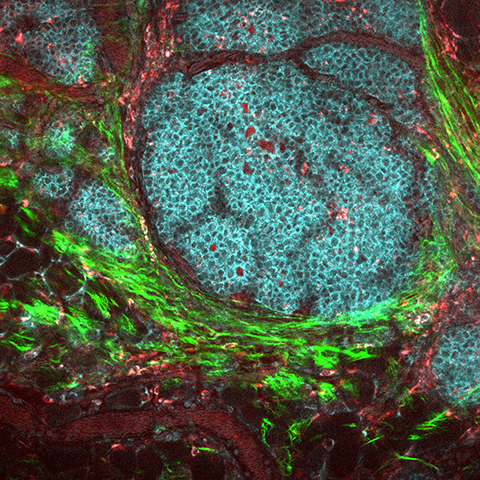How opposing metabolic pathways regulate inflammation
Inflammation is a biological response to harmful stimuli. When activated, innate immune cells, such as macrophages, go after the invader. Like soldiers on a battlefield, sending out flares and calling upon resources, pro- and anti-inflammatory signals must be closely regulated to avoid chaos within macrophages. However, scientists do not fully understand how metabolic players, such as lipids and enzymes, interact to coordinate inflammation.
A normal inflammatory response requires a balance between pro- and anti-inflammatory signals. Such a response can be achieved by competition between the precursors of bioactive metabolites. Macrophages can produce arachidonic acid, a precursor to proinflammatory molecules, and eicosapentaenoic acid, a molecule that inhibits inflammation. These acids, known as AA and EPA, respectively, compete for binding sites on cyclooxygenase, or COX, the enzyme that converts them to their metabolically active products. This competition drives the homeostatic balance between pro- and anti-inflammatory signals in macrophages.

Sana Khanum and Doraisami Ramkrishna at Purdue University, Shankar Subramaniam at the University of California, San Diego, and a team of researchers from the two universities wondered if there was a way they could understand the cross-talk between these apparently opposite processes.
They described their work in a recent paper in the Journal of Lipid Research.
The researchers separated a murine macrophage cell line into either EPA-supplemented or non–EPA-supplemented controls. They applied what they called a “danger signal,” known as adenosine triphosphate, which triggered the inflammatory immune response and then observed the cells’ metabolic profiles. Because one of the groups started with more EPA, an anti-inflammatory signal, the macrophages compensated for the preexisting signal by producing different downstream metabolites compared to a control that had the same starting levels of EPA and AA. By noting the metabolic rates of these groups with different kinds of supplementation, Khanum and Subramaniam observed experimentally how the macrophages regulated inflammatory signals.
The team used a cybernetic approach to mathematically model different AA and EPA production rates in hopes of finding predictive information about macrophage inflammatory signaling. A cybernetic approach is a mathematical system that uses experimental data to create models that may be able to predict bioactivity of proteins such as enzymes.
“It is very difficult to measure every single reaction,” Subramaniam said, “because this is not experimentally feasible.” To address this limitation, his team would take measurements of macrophage production of certain molecules at various times. Then, he said, “We can look at these measurements to build models.”
The cybernetic method assumes that the macrophages have a biological objective. In this case, the researchers assumed the macrophages aimed to maximize their consumption of both AA and EPA. For the two experimental groups, they modeled the enzymatic activity of COX as a function of the concentration of EPA and AA. The cybernetic modeling predicted COX’s metabolic output with varying EPA and AA starting concentrations.
The authors validated their approach by examining how well their mathematical model compared to the experimental groups when given new information. In a series of cross-validation tests, they either removed or added a metabolite, in both the experimental and cybernetic groups, that was not used to train the model to see if the cybernetic framework could anticipate and predict the change — which it did in both tests.
The researchers said that their approach may provide new information for clinicians debating between treatment options for a viral infection, given a patient’s level of baseline inflammation.
“Methods like the cybernetic approach could provide a window for using longitudinal data towards understanding mechanistically what is happening and eventually, to suggest what interventions would be appropriate to help with the infection,” Subramaniam said.
In addition, Subramaniam and Khanum said their work could be used to better understand the effects of over-the-counter anti-inflammatory medications, supplements, and foods. Many people go into a natural foods store and purchase products that are labeled as anti-inflammatory with little knowledge of how they interact with the inflammatory response, Subramaniam said.
“Now we are providing a rationale,” he said, “and saying that ‘hey, you know, this is the meaning of what your diet supplementation does for you.’”
Enjoy reading ASBMB Today?
Become a member to receive the print edition four times a year and the digital edition monthly.
Learn moreGet the latest from ASBMB Today
Enter your email address, and we’ll send you a weekly email with recent articles, interviews and more.
Latest in Science
Science highlights or most popular articles

Bacteriophage protein could make queso fresco safer
Researchers characterized the structure and function of PlyP100, a bacteriophage protein that shows promise as a food-safe antimicrobial for preventing Listeria monocytogenes growth in fresh cheeses.

Building the blueprint to block HIV
Wesley Sundquist will present his work on the HIV capsid and revolutionary drug, Lenacapavir, at the ASBMB Annual Meeting, March 7–10, in Maryland.

Gut microbes hijack cancer pathway in high-fat diets
Researchers at the Feinstein Institutes for Medical Research found that a high-fat diet increases ammonia-producing bacteria in the gut microbiome of mice, which in turn disrupts TGF-β signaling and promotes colorectal cancer.

Mapping fentanyl’s cellular footprint
Using a new imaging method, researchers at State University of New York at Buffalo traced fentanyl’s effects inside brain immune cells, revealing how the drug alters lipid droplets, pointing to new paths for addiction diagnostics.

Designing life’s building blocks with AI
Tanja Kortemme, a professor at the University of California, San Francisco, will discuss her research using computational biology to engineer proteins at the 2026 ASBMB Annual Meeting.

Cholesterol as a novel biomarker for Fragile X syndrome
Researchers in Quebec identified lower levels of a brain cholesterol metabolite, 24-hydroxycholesterol, in patients with fragile X syndrome, a finding that could provide a simple blood-based biomarker for understanding and managing the condition.

